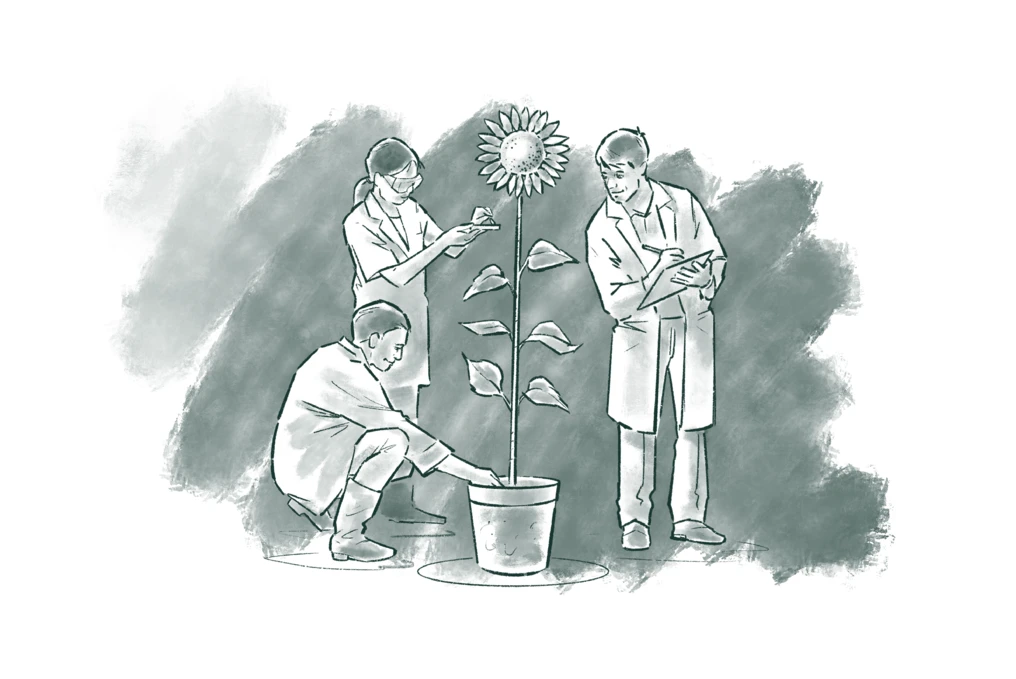Humans, plants, and animals share a genetic kinship through the fundamental building blocks of life. This interconnectedness provides a foundation for inspiring sustainable biology-based solutions in industrial manufacturing by drawing upon the intricate biological processes and adaptability found in nature.
What plants can teach us

By understanding and harnessing the genetic similarities and evolutionary relationships between these organisms, we can develop innovative, sustainable approaches to manufacturing that align with the resilience and efficiency seen in natural systems.
Imagine a reunion where every living organism that ever existed on Earth has gathered. What you’ll find at the center of this grand celebration would be the great Luca. Who is Luca? Well, Luca stands for “Last Universal Common Ancestor”, a humble bacteria-like microscopic organism that came into existence on Earth around four billion years ago and kickstarted the brilliant journey of evolution.
Exploring this intricate web of life, scientists have discovered a remarkable truth: despite our diverse forms and functions, we are all connected by invisible threads of genetic kinship. And these genes have been passed on from one generation to another, for as long back as the evolution started.
Here's where things get fascinating: because we all come from the same ancestor and genes pass on from one generation to another, we humans actually share a lot of genes with other living beings! Yep, that's right—humans, plants, animals, even bacteria—we're all kind of like distant cousins in the big family of life. For example, did you know that we share genetic similarities with a banana? And you thought we’re just related to the chimps and gorillas.
We're all part of one big genetic family tree, with branches reaching out to every corner of the natural world.
Siblings to our help
Now that you know that all living organisms are part of one huge family, answer this question – what do families do? Simple, they help each other! Like any sibling that reaches out to its kin in times of need or when facing a challenge, humans have been reaching out to their genetic kin for millions of years seeking solutions for challenging problems.
From ancient humans discovering farming for growing food and using sheep wool to make clothes to the latest technologies of using viruses to develop vaccines against deadly diseases, humans have always relied on plants, animals, and microbes to improve their lives.

Microbes are found in the harshest places
However, among all our genetic kin, plants and microbes have stood out as the most versatile sources of solutions to our problems. Why? Because both plants and microbes, like bacteria and fungi, can be found living in some of the harshest places on the planet, from the freezing polar ice caps to the boiling volcanoes. Their resilience powered by their varying evolutionary journeys makes them the best candidates for scientific studies to seek biological solutions to our real-world problems.
And that is how humans started finding biological solutions a.k.a. Biosolutions — answers to pressing problems ranging from medicine to environmental interventions. Now, let’s take a look at some of the ways we have been utilizing plants and microbes to develop biosolutions.

Natures pharmacy
Biosolutions also offer a hearty and healthy breakfast
Most of the world’s population is lactose intolerant but milk is a nutritional and tasty part of many people’s breakfast, especially for children. Biosolutions have made it possible to remove lactose (milk sugar) from milk. Not just that, but also adding more dairy fibers to the milk and reducing the addition of sugar for those who prefer low-sugar foods.
Plants as medicine cabinets
In the quest for healing, humans have long turned to nature's pharmacy – harnessing the medicinal properties of plants. Traditional healing systems worldwide have relied on the wisdom of herbal remedies, utilizing leaves, roots, and fruits to combat ailments and restore balance to the body.
Take, for example, Paclitaxel, a chemotherapy drug derived from the bark of the Pacific Yew tree. The drug was discovered thanks to a collaborative effort between National Cancer Institute medical researchers and botanists from The United States Department of Agriculture who set out to sift through at least a thousand trees to find a drug for cancer. Paclitaxel has saved countless lives and earned its place on the World Health Organization's list of essential medicines.
However, the demand for Paclitaxel threatened the survival of its source—the majestic Pacific Yew trees. In response, scientists turned to another unlikely ally: fungi. By tapping into the microbial world, researchers discovered fungi species capable of producing Paclitaxel in abundance, offering a sustainable solution to the drug's production while safeguarding the biodiversity of our forests.
Beyond Paclitaxel, plants harbor a treasure trove of medicinal compounds —flavonoids, alkaloids, terpenoids, and polyphenols—that hold the promise of new treatments for a myriad of ailments. From antioxidant-rich fruits to potent painkillers derived from opium poppies, the botanical kingdom continues to inspire breakthroughs in modern medicine.
Plants are redefining plastics
Plastic, the ubiquitous material of modern life, poses a looming threat to our planet's health, choking waterways, and clogging landfills. Yet, in the green embrace of plants, we find a beacon of hope for a more sustainable future.
Unlike regular plastic which is made from crude oil and is hard to destroy, the PLA plastic offers a guilt-free solution. As it is made from plants, it gets degraded like banana peel in a compost. The ingenuity of this biosolution extends beyond the laboratory, as companies like Carbios have already pioneered the processes to make PLA plastic that can degrade up to 90% within just 48 hours.
Plant enzymes add value to human products
All living organisms – humans, animals, microbes, plants, or any other life form – produce a natural product called enzymes, which are crucial for our survival. Enzymes help regulate various functions in the body, like generating energy from the food we eat. As humans studied plants, they realized that plants produce various enzymes that can help us make our lives easier, foods taste better and daily lives more sustainable and environment-friendly.
Among the many plant enzymes, one group of enzymes called Proteases stand out as versatile workhorses with myriad applications. Among all the commercially developed enzymes-based products, around 60 percent account for proteases.
Some examples of how proteases are used in the industries include:
- Food industry: Proteases are utilized in food processing to enhance flavor, texture, and nutritional value. For example, in the dairy industry, they are used to make cheese of desirable taste and texture characteristics. Proteases are also used to tenderize meat to improve the palatability of meat products.
- Detergent production: Proteases enhance the capability of detergents to break down hard-to-remove stains like blood, grass, and food residues. This helps not just make detergents more efficient but also leads to their less use, ultimately proving beneficial for the environment.
- But proteases are just the tip of the enzymatic iceberg. Plants and microbes boast a wide array of enzymes like amylase, invertase, papain, and laccase that find uses in diverse industries such as textiles, pharmaceuticals, paper, food, and leather.
This article is part of The biosolutions bulletin. Want it in your inbox every month?

Detoxifying the environment
Plants possess an extraordinary capability known as phytoremediation—a process where they serve as natural purifiers, detoxifying soil and water contaminated with pollutants. This remarkable ability allows species like sunflowers and willow trees to play a vital role in environmental restoration efforts worldwide.
In the aftermath of the Chernobyl nuclear disaster, sunflowers were used in the remediation process. Thousands of these resilient plants were strategically planted in contaminated soil to absorb a dangerous radioactive material called caesium. The same exercise was undertaken in Japan, at Fukushima, in the aftermath of the nuclear disaster there.
Another example is that of the commonly available plant, White Rabbit's Foot. Researchers in Europe discovered that the plant produces an enzyme called Hydroxynitrile Lyase (HNL) that can be used to clean up toxic waste in industries containing cyanide. This enzyme also finds potential usage as an insect repellant.
These examples underscore the invaluable contribution of plants in addressing complex environmental challenges.

Algae at the forefront of innovations
An unlikely hero has emerged for developing biosolutions: algae. While algae are not technically considered plants, they also perform photosynthesis, the crucial process where plants turn sunlight into energy-packed sugar for fueling their survival.
Photosynthesis is essential for life on Earth as it is the primary process by which oxygen is generated in the atmosphere, providing the oxygen that animals and other organisms need to breathe. Additionally, photosynthesis is the foundation of the food chain, as plants are the primary producers that provide energy-rich molecules for other organisms to consume.
Despite being microscopic, these tiny organisms are ready to pack a punch when it comes to helping humans tackle some of our most pressing challenges.
They have been creating waves in food production for a while now. Spirulina, a kind of algae that dates its origins to around 3.6 billion years, is a popular protein supplement for those seeking alternative plant-based proteins.
A lot of research work is going on in extending algae's contributions beyond being a fuel pump or ending up on our dinner plates. They're also being tested for detoxifying polluted waters, and producing cosmetics, bioplastics, and pharmaceuticals.
Using plants to strengthen plants
Agriculture is facing two major challenges now, climate change and the falling quality of soil due to high fertiliser and pesticide usage. Plants have inbuilt mechanisms that make them resilient against changes in climate and pests. However, due to rapid changes, they are not proving strong enough. So researchers looked at ways of strengthening these internal mechanisms. Enter, biostimulants!
Biostimulants are like personal trainers for plants, boosting their natural abilities to grow, develop, and fight against external stress, enhancing their performance from the inside out. Biostimulants are usually derived from natural sources like seaweed or beneficial bacteria and fungi. They make plants better at absorbing nutrients, coping with environmental stresses like droughts, and improving their immunity.
Biostimulants can be applied to seeds, soil, or roots, depending on the specific product and the plant's needs.
In a world where climate change is a growing concern, biostimulants offer a promising avenue for adapting agriculture to changing conditions and ensuring food security for future generations.
Other important solutions to sustain this challenged, but important sector include biofungicides offering protection against soil and foliar diseases and bionematicides protecting roots from nematode (roundworm) attacks and limiting their presence. This has a positive effect on crop yield, robustness, root system stability and water use efficiency.
An untapped potential
An untapped reservoir of biosolutions lies within the intricate ecosystems of our planet, waiting to be discovered and harnessed for the betterment of humanity. For millennia, humans have turned to plants and microbes for sustenance, medicine, and shelter. Yet, it is only in recent centuries, with the advent of biotechnology, that we have begun to unlock the full potential of these ancient allies.

Each new discovery brings us closer to a greener society
With over 400,000 species of plants gracing our planet, each possessing unique adaptations and biochemical pathways, the potential for discovery is staggering. The biosolutions we have developed thus far represent merely a fraction of what nature has to offer. From renewable energy sources to sustainable materials, from novel pharmaceuticals to ecological restoration, the applications of plant and microbial-based technologies are limited only by our imagination.
What makes these biosolutions truly remarkable is their inherent sustainability. Unlike the finite resources of fossil fuels or the environmental degradation caused by industrial processes, nature's innovations operate in harmony with the Earth's ecosystems, replenishing rather than depleting our shared resources. Each new discovery brings us closer to a future where human ingenuity aligns seamlessly with the wisdom and diversity of the natural world, paving the way for a greener, more resilient society.
Plant fun facts:
- Medicinal plants in focus:
According to The International Union for Conservation of Nature, there are around 50,000-70,000 known species of plants worldwide used in traditional and modern medicine. Approximately 15,000 species are threatened and require special attention for conservation efforts.
- Global leaders in medicinal plant production:
Brazil boasts the highest plant species diversity globally, with over 34,000 species. However, China takes the lead in medicinal plant production and exportation, contributing almost 25% to global exports.
- Plant-based vaccines:
Plants are transforming vaccine production through biotechnology, serving as natural factories for immunity against diseases in both humans and animals. This approach offers the promise of cheaper, easily storable vaccines that can be mass-produced. Notably, Canada approved a plant-based COVID-19 vaccine grown in the Australian weed, Nicotiana benthamiana.
- Ancient origins of writing materials:
In ancient Egypt, the papyrus plant was processed into sheets for writing material production. Widely used for writing texts, documents, and records, papyrus became an essential medium for communication and record-keeping. Similarly, ancient India utilized the bark of the mulberry tree to create a parchment-like paper.
- Tiny medical robots made from plant-based gel:
A team of researchers at the University of Waterloo created incredibly small robots that can perform delicate medical tasks inside the body. What's really cool about these robots is that they're made from a special self-healing gel derived from plants, making the robots safe to use inside the body and eco-friendly too. These tiny robots can navigate through tight spaces inside the body and deliver tiny things like cells or tissues exactly where they're needed.

Taste the future: Fermented plant-based foods made with biosolutions
In the bustling realm of food innovation, fermented plant-based foods are having their moment in the spotlight, captivating both taste buds and eco-conscious hearts. From leading a quiet life on the sidelines of mainstream diets, the vegetal cuisine is now taking center stage, and many efforts are put into elevating its culinary appeal.
Join us as we delve into the world of fermented plant-based foods, exploring the innovative strides being made to elevate these dishes and make them a staple in modern diets.
What is a biosolution?
Microbes and enzymes are tiny but mighty agents of change. For billions of years, they’ve enabled transformation in all living things through microbiology.

What are biosolutions? Where do they come from?
How do they work? What would the world look like without them?
Get the answers to these questions and more from the monthly biosolutions bulletin. Whether you’re an expert who wants to keep on top of the latest innovations or just starting to learn about biosolutions, we’ve got you covered.
With stories ranging from the role of biosolutions in food security to how they enable NOMA-style dining experiences, there’s something for everyone.
Don’t miss out on the latest news about how biosolutions better our world. Sign up to get the biosolutions bulletin delivered directly to your inbox.
One more step…
To complete the get in touch form or sign up, please click on the button below to enable cookies.